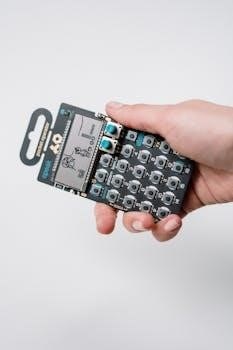Honeywell Alarm Keypad User Manual⁚ A Comprehensive Guide
This comprehensive guide serves as your go-to resource for understanding and utilizing your Honeywell alarm keypad․ We delve into essential aspects‚ from basic operations to advanced features‚ providing clear instructions and troubleshooting tips․ Whether you’re a new user or seeking to optimize your system‚ this manual equips you with the knowledge for effective home security management․
Overview of Honeywell Alarm Keypad Models
Honeywell offers a diverse range of alarm keypads designed to cater to varying security needs and system configurations․ These keypads serve as the primary interface for interacting with your Honeywell security system‚ allowing you to arm/disarm the system‚ bypass zones‚ view system status‚ and respond to alarms․ The models vary in features‚ display type (fixed English‚ alphanumeric‚ or touchscreen)‚ and communication capabilities (wired or wireless)․ Some keypads incorporate built-in transceivers for wireless device support‚ enhancing system flexibility․
Popular models include the 6150‚ a fixed-English keypad; the 6160‚ an alphanumeric keypad providing detailed zone descriptions; and the ADEMCO 6160RF‚ a keypad/transceiver combo․ Wireless options like the Ademco 5828 and 5804BDV offer convenient remote control and status indication․ Touchscreen keypads‚ such as the 6270 and 6271‚ provide intuitive graphical interfaces for ease of use․
Understanding the specific features and functionalities of your Honeywell keypad model is crucial for effective system operation․ This guide will explore several key models‚ providing insights into their unique attributes and operation․
Understanding the Honeywell 6150 Keypad

The Honeywell 6150 is a fixed-English keypad commonly used with Honeywell security systems․ It provides a straightforward interface for basic system operations․ The 6150 features a numeric keypad for entering security codes and function keys for common tasks like arming‚ disarming‚ and bypassing zones․ The display uses pre-designated English-language prompts (e․g․‚ ALARM‚ AWAY‚ STAY‚ CHECK) to indicate system status․
While lacking the detailed alphanumeric display of some other models‚ the 6150 offers simplicity and ease of use‚ particularly for users who prefer a less complex interface․ It is addressable‚ allowing for multiple keypads within the same system․ The keypad can either be set for an address of 00-30‚ or to the non-addressable mode (31)․ The keypads default address is 31․ To change the keypads address‚ do the following⁚ 1․ Enter address mode⁚ Power up the keypad․ Within 60 seconds of power-up‚ press and hold down the 1 and 3 keys at the same time for 3 seconds․ (If unable to enter
Understanding the meaning of the fixed-English prompts is essential for interpreting system status and responding appropriately․ The 6150 also includes LEDs to indicate system readiness and alarm conditions․ Despite its simplicity‚ the 6150 provides essential security system control․
Honeywell 6160 Keypad Features and Operation
The Honeywell 6160 keypad is a more advanced model than the 6150‚ offering a 32-character alphanumeric display for clearer communication and enhanced functionality․ This keypad allows for zone descriptions‚ system messages‚ and more detailed information to be displayed‚ making it easier to understand system events and troubleshoot issues․ The 6160 also includes function keys for quick access to common commands such as arming‚ disarming‚ bypassing zones‚ and initiating panic alarms․
One of the key features of the 6160 is its ability to display zone descriptions‚ which helps users identify the specific location of an alarm event․ This is particularly useful in larger homes or businesses with multiple zones․ The keypad also supports advanced programming options‚ allowing installers to customize the system to meet specific needs․
Operationally‚ the 6160 functions similarly to other Honeywell keypads‚ requiring a user code to arm and disarm the system․ However‚ the alphanumeric display provides clearer prompts and feedback‚ making it easier to navigate the system’s features․ The function keys can also be programmed for special functions or panic alarm activations․ Refer to the 6162V Keypad Voice Features section for details using these keys․

ADEMCO 6160RF Keypad/Transceiver Functionality
The ADEMCO 6160RF is a combination keypad and transceiver unit‚ integrating the features of a 6160 alphanumeric keypad‚ a 5881H RF receiver‚ and a 5800TM transmitter module into a single device․ This integration allows for both wired keypad functionality and wireless device communication‚ offering enhanced flexibility and convenience in system design and installation․
The 6160RF keypad/transceiver can be used with any control panel that supports 5800 Series wireless devices‚ such as the VISTA-10P‚ VISTA-15P‚ and VISTA-20P․ This allows for seamless integration of wireless sensors and devices into the security system‚ expanding coverage and capabilities without the need for extensive wiring․
Key features of the 6160RF include its alphanumeric display‚ which provides clear and detailed system information‚ as well as its ability to support a wide range of wireless devices․ The transceiver functionality allows the keypad to receive signals from wireless sensors and transmit commands to wireless devices‚ such as key fobs or sirens․ Additionally‚ the 6160RF supports function keys for quick access to common commands and can be programmed for special functions or panic alarm activations․ See the keypads User Guide for details․
Programming and Addressing Keypads (Address Mode)
Honeywell keypads‚ such as the 6150 and 6160 series‚ often operate in addressable mode‚ requiring a unique address for proper communication with the control panel․ This address allows the system to differentiate between multiple keypads and ensure commands are correctly executed․ The keypad can be set for an address of 00-30‚ or to the non-addressable mode (31)․ The keypads default address is 31․ To change the keypads address‚ do the following⁚
To program the keypad address‚ you typically need to enter address mode․ Power up the keypad․ Within 60 seconds of power-up‚ press and hold down the 1 and 3 keys at the same time for 3 seconds․ (If unable to enter․ This usually involves pressing a specific combination of keys within a short timeframe after powering on the keypad․ Refer to your specific keypad model’s installation manual for the exact key sequence and timing requirements․
Once in address mode‚ you can use the numeric keys to enter the desired address․ Ensure that the address you choose does not conflict with any other devices on the system․ After setting the address‚ save the changes and exit address mode․ The keypad should now communicate with the control panel using the assigned address․ If you’re not sure which is the manual
Troubleshooting Common Keypad Issues (Technical Notification 41)
Honeywell alarm keypads‚ while generally reliable‚ can sometimes encounter issues that require troubleshooting․ One notable issue is addressed in Technical Notification 41‚ which alerts users to possible problems with a 6150 Keypad; The issue prevents dual-button panic functions from working correctly․ 6150 Keypads with a date code between C107 and C200 may be affected․ Check out Resideo Technical Notification 41․
This notification specifically highlights a potential defect affecting the dual-button panic functions on certain 6150 keypads․ If your keypad falls within the specified date code range (C107 to C200)‚ it’s crucial to investigate further to ensure the panic functions are working correctly․ Symptoms may include the inability to trigger a panic alarm by pressing the designated button combinations․
To resolve this issue‚ consult Resideo Technical Notification 41 for detailed instructions and recommended actions․ This may involve contacting a qualified technician to inspect and potentially replace the affected keypad․ Addressing this issue promptly is vital to maintain the security and safety features of your Honeywell alarm system․
Panic Alarm Activation and Function Keys
Honeywell alarm keypads often include panic alarm activation features and programmable function keys for enhanced security and convenience․ Panic alarms can be triggered via dedicated buttons or key combinations‚ providing a quick way to summon help in emergencies․ The specific activation method may vary depending on the keypad model‚ so consult your user manual for detailed instructions․

Function keys can be programmed for special functions or panic alarm activations․ These keys offer customizable shortcuts for frequently used commands‚ such as arming or disarming the system‚ bypassing zones‚ or initiating specific alarm responses․ The programming of function keys is typically done by the system installer‚ who can tailor them to your specific needs and preferences․
It’s important to familiarize yourself with the location and operation of panic alarm buttons and programmed function keys on your Honeywell keypad․ In an emergency‚ knowing how to quickly activate a panic alarm or execute a critical command can make a significant difference․ Refer to your keypad’s user guide for detailed information on panic alarm activation methods and function key programming․
Wireless Keypad Options⁚ Ademco 5828 and 5804BDV
Honeywell offers wireless keypad options like the Ademco 5828 and 5804BDV‚ providing flexibility in system operation․ The Ademco 5828 is a wireless bidirectional fixed-word keypad‚ allowing users to interact with the system remotely․ It features a numeric display for zone identification and pre-designated English prompts indicating system status‚ offering convenient control and feedback․
The Ademco 5804BDV is a two-way wireless key with voice status‚ functioning as a four-button remote control․ It sends commands to the alarm system‚ such as arming or disarming‚ and receives system status updates․ Two LEDs and a speaker indicate system status‚ enhancing user awareness․ The 5804BDV includes function keys for panic alarm activation‚ triggered by pressing key pairs․
These wireless keypads provide convenient alternatives to traditional wired keypads‚ offering greater mobility and ease of installation․ The panic alarms can be activated by pressing key pairs or a Special Function Key․ Whether these panic keys function and the type of panic alarms they produce is determined by the control panels capability and programming․
Bypassing Zones Using the Keypad
Bypassing zones is a useful feature that allows you to temporarily exclude specific areas from your Honeywell alarm system’s protection․ This is particularly helpful when you need to disarm a particular zone‚ like a window you want to keep open‚ while still arming the rest of your system․ Using the keypad‚ you can easily bypass these zones‚ ensuring that they don’t trigger false alarms․
To bypass a zone‚ you’ll typically enter your user code‚ followed by the bypass command․ The keypad will then prompt you to enter the zone number you wish to bypass․ It’s crucial to refer to your system’s user manual for the exact sequence and commands‚ as they can vary depending on the model․ Once you’ve entered the zone number‚ the keypad will confirm that the zone has been bypassed․
Remember that bypassing a zone means it will not be monitored while the system is armed․ Therefore‚ it’s essential to reinstate the zone once the reason for bypassing it no longer exists․ The keypad will usually display a notification indicating which zones are currently bypassed‚ reminding you to re-enable them when appropriate․ Always prioritize security and only bypass zones when absolutely necessary․
Finding User Manuals and Support Resources
Locating the correct user manual for your Honeywell alarm keypad is crucial for understanding its features and troubleshooting any issues․ The primary source for your specific keypad model’s manual is often the Honeywell Home Security website․ You can typically find a comprehensive library of manuals in PDF format‚ searchable by model number․

If you’re unable to find the manual online‚ consider contacting your alarm system installer․ They may have provided a physical copy or be able to direct you to the correct digital version․ Additionally‚ many online security forums and communities dedicated to Honeywell systems can offer valuable information and resources․
Beyond user manuals‚ Honeywell and its authorized dealers provide various support channels․ Their websites often feature FAQs‚ troubleshooting guides‚ and contact information for technical support․ Many dealers also offer phone support‚ online chat‚ and even on-site service for more complex issues․ Remember to have your system’s model number and any relevant details readily available when seeking support to expedite the process․ Utilizing these resources ensures you can effectively manage and maintain your Honeywell alarm system․
